#andean fashion
Explore tagged Tumblr posts
Text
Gothic Cholita

Gothic Andeans
#gothic#gothic girl#cholita#andean#andeans#goth aesthetic#goth girl#alternative goth#goth fashion#quechua#amaru#andean Fashion#fashion
14 notes
·
View notes
Text

Renata Flores Rivera con Retablos Ayacuchano 💚☀️💚
#Masillaykuna <3#renata flores rivera#Miski warmi <3#Ayacucho#indigenous to ayacucho#indigenous Quechua#quechua culture#Ayacucho Quechua Culture#Retablos#Retablos Ayacuchano#art#non andeans do not appropriate her hair#trenzas andinas#green aesthethic#beautiful women#brown is beautiful#ndn women#ndn fashion#Andean fashion#Andean pride#andean textiles#Andean embroidery#Ayacucho embroidery#Embroidery#Quechua#Quechua Ayacuchana#bipoc representation#bipoc artists#Support Andean art#Support Andean indigenous arts
141 notes
·
View notes
Text
I love how traditional he is! If you want to make the design more “cyberpunk” i suggest you play more with chrome, metals, and shiny minerals.
for men, gold was a “masculine” color for it represented Inti, the sun.
For women, Silver was “feminine” as it represented killa/quilla, the moon.
And brass color metals was popular too.
You could use chunky metal cuffs that act as tech.
ear piercings that act as communication devices.
minerals that glow, metal sheets as light weight amor that when activated covers the entire body.
I suggest you also look at Andean street fasion, I know that the south of Peru has “modern” fashion you might be interested in seeing that uses bells, and sequins that are flashy and eye catching. Along with modern and silhouettes
-
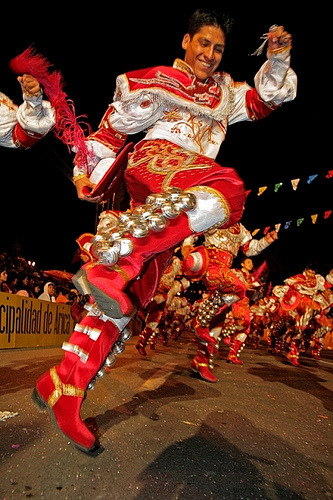
this is a man in Caporal dancing gear
-

these are two Bolivian Caporales dancers. Women have hair embellishments and destinct eye makeup.

I hope these help!
I NEED ADVISE!!!
I’m writing a comic set in post nuclear apocalyptic Peru. It’s been a long time since the war and one settlement was able to survive and rebuild and thrive.
I wanted to mix modern fashions and Ancient ones together, like society has ‘reset’ and taken inspiration from the Incan Empire but still has access to some modern technologies.
It’ll also mix in some cyberpunk elements as well.
This is the ‘ruler’ of the settlement and father of my main character Anyu.
I’m really struggling with his design. I wanted him to be more of the ancient traditional man but at the same time I feel like he doesn’t have enough modern elements to his design.
How can I add a few more modern/cyberpunk elements without changing him too much?
I also want to make sure his design never seems offensive as that’s hugely important to me.
If anyone could give me advice I’d be so grateful!!
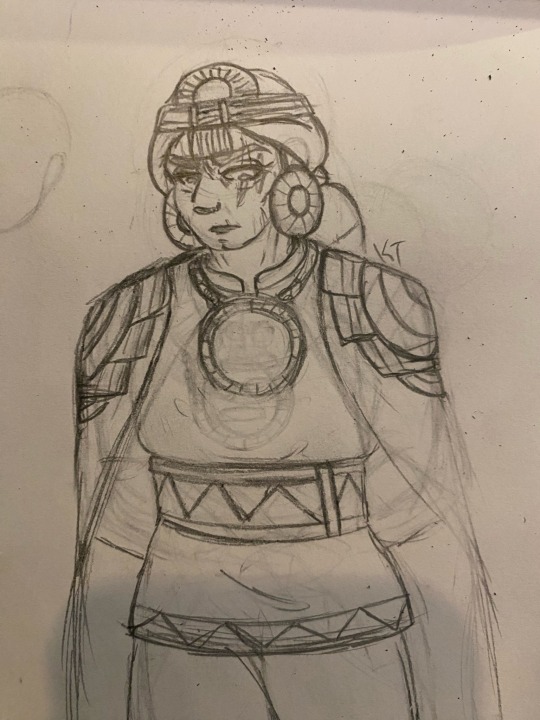
80 notes
·
View notes
Text

for @kataang-week -- day 4: cultural exchange
(ID: a digital drawing of katara and aang from atla. they're wearing clothing from each other's cultures. katara is wearing a yellow chuba with red trim, an orange shirt, a chumpi belt, and boots. she has one necklace with small turquoise beads and one with large yellow beads. aang is wearing a parka with a thick fur hood and black-and-white geometric patterns, and dark blue pants. he also has mittens and large boots on. they're smiling at each other, with pink hearts floating between them.
#kataang week#kataang#kataang fanart#artists on tumblr#atla#avatar: the last airbender#cimmeriadraws#the chumpi belt is a traditional andean garment#i assume part of the reason tibet serves as inspo for the air nomads is the high altitude of where they live#and quechua people also live in high altitudes so i think they'd be interesting to pull inspiration from for air nomad clothing#plus atla has already taken inspo from south american cultures with the sun warriors so it works :)#but anyway all i have in this drawing is the chumpi belt so i'd like to incorporate more andean culture into air nomad designs in the futur#i also want to dive some more into siberian and alaskan indigenous clothing for the southern water tribe fashion#and explore ideas for differences between nwt and swt clothing
302 notes
·
View notes
Text

Ana Flores Captures Her Andean Heritage Through a Fashion Photography Lens
282 notes
·
View notes
Text
Word List: Fashion History
to try to include in your poem/story (pt. 3/3)
Pelete Bite - a fabric created by the Kalabari Ijo peoples of the Niger Delta region by cutting threads out of imported cloth to create motifs
Pelisse - a woman’s long coat with long sleeves and a front opening, used throughout the 19th century; can also refer to men’s military jackets and women’s sleeved mantles
Peplos - a draped, outer garment made of a single piece of cloth that was worn by women in ancient Greece; loose-fitting and held up with pins at the shoulder, its top edge was folded over to create a flap and it was often worn belted
Pillow/Bobbin Lace - textile lace made by braiding and twisting thread on a pillow
Pinafore - a decorative, apron-like garment pinned to the front of dresses for both function and style
Poke Bonnet - a nineteenth-century women’s hat that featured a large brim which extended beyond the wearer’s face
Polonaise - a style of dress popular in the 1770s-80s, with a bodice cut all in one and often with the skirts looped up; it also came back into fashion during the 1870s
Pomander - a small metal ball filled with perfumed items worn in the 16th & 17th centuries to create a pleasant aroma
Poulaine - a shoe or boot with an extremely elongated, pointed toe, worn in the 14th and 15th centuries
Raffia Cloth - a type of textile woven from palm leaves and used for garments, bags and mats
Rebato - a large standing lace collar supported by wire, worn by both men and women in the late 16th and early 17th century
Robe à L’anglaise - the 18th-century robe à l’anglaise consisted of a fitted bodice cut in one piece with an overskirt that was often parted in front to reveal the petticoat
Robe à la Française - an elite 18th-century gown consisting of a decorative stomacher, petticoat, and two wide box pleats falling from shoulders to the floor
Robe en Chemise - a dress fashionable in the 1780s, constructed out of muslin with a straight cut gathered with a sash or drawstring
Robe Volante - a dress originating in 18th-century France which was pleated at the shoulder and hung loose down, worn over hoops
Roses / Rosettes - a decorative rose element usually found on shoes in the 17th century as fashion statement
Ruff - decorative removable pleated collar popular during the mid to late 16th and 17th century
Schenti - an ancient Egyptian wrap skirt worn by men
Shirtwaist - also known as waist; a woman’s blouse that resembles a man’s shirt
Skeleton Suit - late 18th & early 19th-century play wear for boys that consists of two pieces–a fitted jacket and trousers–that button together
Slashing - a decorative technique of cutting slits in the outer layer of a garment or accessory in order to expose the fabric underneath
Spanish Cape - an outer wrap often cut in a three-quarter circle originating from Spain
Spanish Farthingale - a skirt made with a series of hoops that widened toward the feet to create a triangular or conical silhouette, created in the late 15th century
Spencer Jacket - a short waist- or bust-length jacket worn in the late 18th and early 19th centuries
Stomacher - a decorated triangular-shaped panel that fills in the front opening of a women’s gown or bodice during the late 15th century to the late 18th century
Tablion - a rectangular panel, often ornamented with embroidery or jewels, attached to the front of a cloak; worn as a sign of status by Byzantine emperors and other important officials
Toga - the large draped garment of white, undyed cloth worn by Roman men as a sign of citizenship
Toga Picta - a type of toga worn by an elite few in Ancient Rome and the Byzantine Empire that was richly embroidered, patterned and dyed solid purple
Tricorne Hat - a 3-cornered hat with a standing brim, which was popular in 18th century
Tupu - a long pin used to secure a garment worn across the shoulders. It was typically worn by Andean women in South America
Vest/Waistcoat - a close-fitting inner garment, usually worn between jacket and shirt
Wampum - are shell beads strung together by American Indians to create images and patterns on accessories such as headbands and belts that can also be used as currency for trading
Wellington Boot - a popular and practical knee- or calf-length boot worn in the 19th century
If any of these words make their way into your next poem/story, please tag me, or leave a link in the replies. I would love to read them!
More: Fashion History ⚜ Word Lists
#word list#fashion history#writeblr#dark academia#terminology#spilled ink#writing prompt#writers on tumblr#poets on tumblr#poetry#literature#light academia#fashion#lit#studyblr#langblr#words#linguistics#history#culture#creative writing#worldbuilding#writing reference#writing resources
105 notes
·
View notes
Text

Happy Pride Month and (very belated) Solarpunk Aesthetic Week! I wanted to redesign my longtime OCs, so I decided to give them a thematic twist!
Self-indulgent details about their designs under the cut:
⸻⸻⸻⸻⸻
From left to right:
Mia Based on the romantic/cottagecore style, and incorporating aspects of Eastern/Central European folk dresses, such as the Czech kroj. Her vest is made from recycled overalls and excess fabric from her apron. Her natural motif is fungi -- her bow and earrings are amanita mushrooms (if you squint, her skirt looks like one too), and the frills on her collar + sleeves are chanterelles!
Clyde He's a bohemian kinda guy, so I kept his silhouette relaxed and unstructured + harem pants + accessories. The exception is his jacket, a union of 3 different garments made to loosely resemble traditional Indian clothing like the achkan. His natural motif is the sun - hence the warm tones, which is contrasted with splashes of teal, the colour of his aura (its a fictional superpower thing).
Glace His style is more preppy/academia - turtlenecks and sweaters are his type, so I gave him 3! Sewn together in a visible mending-esque style (inspired by tumblr solarpunks and their fashion projects)! His palette is taken from the mlm flag, and there's subtle elements of a Korean hanbok - his collar, sleeve shape, sash and tassel. Rips in his pants are covered by cloud patches (his motif), all dyed to match the aesthetic!
Simmer Her thing is streetwear with a cultural twist - her top combines a bomber jacket and a Chinese qipao/cheongsam. Her detachable sleeves are extended via sewn-on zippers (useful as her powers generate a lot of heat)! Her motif is the phoenix, with patterns on her shirt and collar, hand-decorated using the batik method. Her hair streaks are inspired by stripes on a tiger - Malaysia's national animal.
Axis She's all about the y2k aesthetic, with translucent tights and a hoodie stylishly revamped to form a super crop top + a figure-hugging bodysuit. Her design is inspired by indigenous Andean fashion, such as the Ecuadorian pollera, which her skirt might be repurposed from. Her motif is butterflies, as seen in her earrings, the shape of her bodysuit, and the wing-like curves of her skirt.
Piper Initially wanted a punk-ish vibe for him but he might be a bit too cute now oops! His jacket is a mashup of 3 different pieces, and his jeans are a patchwork of denim. He's got iconic looks from French fashion (beret and scarf), as well as some African designs (the vertical pattern I referenced looked like plant cells, but also like binary code? I thought it was so on theme)! His motif is obviously plants of all types!
⸻⸻⸻⸻⸻
Thank you for checking this out (especially if you got this far)!!! ♡♡♡
#art#artists on tumblr#character design#pride#solarpunk#fashion#culture#oc#wish i couldve finished this in time for solarpunk aesthetic week but. drawing is hard ;;#maybe i'll render it in the future#also! im not an expert on cultural clothing so please correct me if i got anything wrong! still learning!#roobiedoodle#the leftoverse#tl mia#tl clyde#tl glace#tl simmer#tl axis#tl piper
93 notes
·
View notes
Text










The Shining Cloth
Dress and Adornement that Glitter
Victoria Z.Rivers
Thames & Hudson, New York 1999, 190 pages, 24,5x31,5cm, with 287 colour illustrations, ISBN 978 0500 019 511
euro 70,00
email if you want to buy [email protected]
Embellishment with glittering substances is a worldwide and ancient practice. Traces of textiles and other artifacts embroidered and embellished with gold were depicted in Assyrian bas-reliefs, frozen in the tombs of the Scythian nomadic horsemen, unearthed with the treasures of the Pharaohs, and preserved in the burials of Andean cultures' high priests and nobles. Cloth may glitter or shine because of its own lustrous qualities, as is the case with silk, or with the help of special treatments and dyes. Materials such as metals, sequins, beads, or mirrors may be used to embellish fabrics as decoration or to attract or deflect spirits in unseen worlds. Gifts from nature can also be cleverly manipulated into shapes and pieces to simulate more precious materials: for example, the iridescent elytra of beetles reflect brilliant metallic greens and violets as if they were gems.
Today these marvelous creations have gained an additional appeal beyond our fascination for lost and traditional civilizations―their visual verve makes them a fertile source of ideas in contemporary fashion and decoration. Victoria Rivers has spent more than a decade in the search for the most spectacular examples of a universally appealing phenomenon. Combining her artist's eye with an in-depth knowledge of textile techniques, she draws on an extraordinary array of specialist anthropological research from all over the world.
Sumptuously illustrated and superbly designed, this odyssey through the world's cultures will captivate those concerned with contemporary fashion and textile history as well as anyone interested in symbol and ritual in traditional societies. Illustrated throughout
30/04/24
#Shining Cloth#Victoria Rivers#textiles books#embroidered textiles#glittering substances#fashion books#fashionbooksmilano
11 notes
·
View notes
Text
brief overview of how i've rewritten saf's backstory, keeping it fairly poe-centric (rather than spinning off into my own setting lore etc.):
saf (again. still toying with a rename) manifested Being Godlike around 3-ish years old, was promptly abandoned by her aedyran parents because Yikes, let's just have another kid, and then was sold off as an agricultural slave (largely based on her godlike features more than any inherent aptitude).
the farming operation (feudal style, vaguely - not entirely sure it was in aedyr) got derailed by a skaen revolt including an Effigy around the time she was eleven or twelve, and she got so scared she lashed out with her latent cipher ability and ripped the Effigy apart. in the aftermath she didn't know if some of the extra casualties were from her or if they were the Effigy's doing.
this was overall not a good thing for her, as she was then sold off to an animancer with vested interest in ciphers. he promised her her freedom (she'd have to work for it, of course) and taught her to read and write, as well as pairing her with what i'm essentially going to refer to as a watchdog, who was a boy a few years older than her who was responsible for 'keeping her safe' - nominally, yes, but also making sure she stayed in line.
unfathomably toxic relationship that was neither siblingesque nor properly romantic developed as a result as they both got older, and saf was taught to Wield her cipher abilities 'properly' (ie, in whatever fashion the animancer deemed suitable). saf is generally disinclined to violence and the inherent invasiveness of a lot of what Using Your Cipher Abilities For Offense entails, so this grated on her as the severity of what she was ordered to do got worse by degrees. sole bonus (?) of this situation was the fact they were constantly traveling, and she got to see a lot of the world this way.
at some point she snapped and Left that situation (gross oversimplification of what happened) and eventually ended up with her adoptive mother in ixamitl, where they lived outside of a small town at the foot of an alps/andean-vibe-type mountain range that featured a geothermal spring. she mostly herded mountain sheep-like animals and tended to the beemoths + doing general homestead & hospitality work. mom is a weaver (?) in addition to being viewed as the town witch (complimentary), as she's likely also a cipher (or. Similar. she needs to be able to handle or be immune to the inherent danger younger, more-emotionally-unstable saf poses as well as protecting her from the wrath/tracking of the situation she left)
she helped saf get a grip on the worst of herself and her traumas, and now saf is still grumpy and slow to trust and a bit too sharp with her sense of humor but still soft in the middle and prone to protagonizing when people are in genuine need. her relationship with her cipher powers is Very. tenuous. she ends up leaving home when a visitor to the springs - probably a traveling alchemist? - who's fascinated by the beemoths ends up stealing a rare and vitally important chrysalis for the next queen beemoth before taking off to the south. that's No Good and mom has been gently bullying saf into leaving home (not bc she wants her gone but bc saf needs to like re-integrate with The World) for awhile, so she sets off to get it back with a few reminders of home in tow and gets across readceras only to get solidly gutpunched with the biawac upon getting a few miles into the dyrwood.
3 notes
·
View notes
Text
Pachamanca and Quechua Culture
Irene booked a cultural experience for us through Pasitos Andinos which is a group of local women who promote and share the traditional Andean culture. We got picked up from Cusco in the morning and were greeted with a song and flower necklaces upon arriving in the Andean village.
The women taught us about all the functions of their traditional clothing and what they signify. We learned that unmarried girls wear their hair in two separate braids with a colorful ribbon to attract men while married women tie their braids together with black ribbon to signify the duality of marriage.
The women spend 6-9 months weaving their own colorful blankets which are used for everything from carrying their babies, bringing lunch to their husbands in the field, protection from rain, and more.
We were also taught how they spin wool into thread and use different plants and bugs to dye the threads.

After the fashion section of the afternoon, our traditional cooking class began. They showed us how they cut all the vegetables sans cutting boards! You are actually meant to cut towards yourself which is everything my Dad taught me not to do; however, it seemed to work really well for them...I probably won't try to replicate it at home.


Much of what we cut went into the soup pot, while the rest was put in bowls as the stone oven, or Huatia, was being heated to prepare a Pachamanca. Pachamanca translates to earth pot and is a cooking method where stones are heated all morning and used to create an oven in the ground.
Irene, Jonathan, and I helped remove the hot stones to layer a variety of potatoes, corn, meats, lima beans, and a package of cheese. We then replaced the stones and buried the oven with cloth and dirt to allow the meal to cook.


While the food was cooking, we learned how to crush dehydrated potatoes or Moraya with a Batan or stone which were then added to the soup.
Together, we unearthed our meal and enjoyed the food we prepared. Irene had her eye on the handmade blankets since we arrived and convinced all three of us to purchase one. They were expensive but seeing how it took each of the women the greater part of a year to create, I'd say it was worth it. It was special to buy them from their creators.


Meeting the Quechua women and getting to spend the entire afternoon with them learning about their culture and traditions was an unforgettable experience.


3 notes
·
View notes
Text
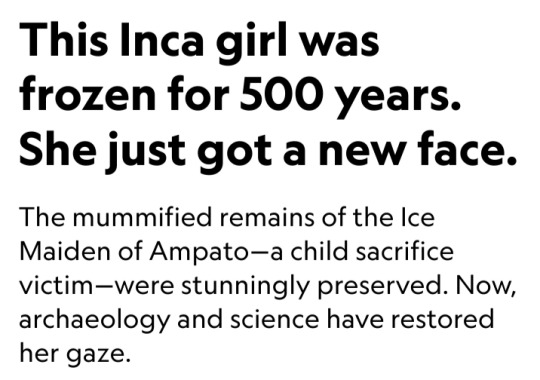
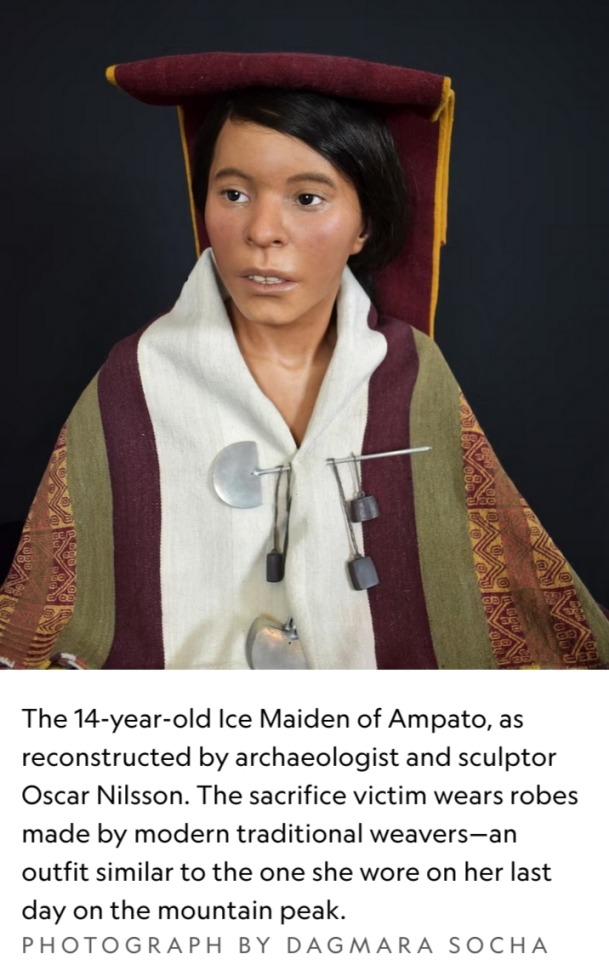
By Erin Blakemore
October 25, 2023
More than 500 years ago, a 14-year-old girl was escorted up an Andean peak and sacrificed to Inca gods.
Buried on the mountain with a variety of offerings, the young woman’s body naturally mummified over time, preserving her hair, her fingernails, the colorful robes she wore on her last day.
But at some point across the centuries, her face became exposed to the elements, her features slowly vanishing over seasons of sunlight and snowfall.
Now, that long-lost face has been recovered thanks to painstaking archaeological analysis and forensic reconstruction.
A striking 3-D bust of the young woman, known today as the Ice Maiden of Ampato, is the centerpiece of a new exhibit in Peru and part of an ongoing effort to understand the drama of human sacrifice practiced in the Andes half a millennium ago.
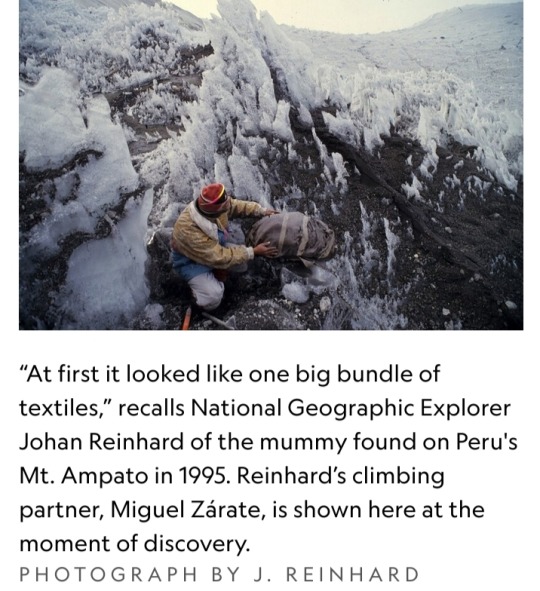
A sacrificial offering
When National Geographic Explorer Johan Reinhard encountered the mummy, also known as Juanita, atop 21,000-foot Mount Ampato during a 1995 expedition, he knew he had discovered something spectacular.
“At first it looked like one big bundle of textiles,” Reinhard recalls. Then he saw the wizened face amid the folds of fabric.
Here was a young victim of the elusive Inca ritual known as capacocha.
Capacocha mostly involved the sacrifice of children and animals who were offered to the gods in response to natural disasters — to consolidate state power in far-flung provinces of the Inca Empire, or simply to please the deities.
The ritual played an important part in sustaining the Inca Empire. It would involve feasts and grand processions to accompany the children, who appear to have been chosen for their beauty and physical perfection.
Being selected for sacrifice, researchers believe, would have considered a deep honor by the child’s family and community.
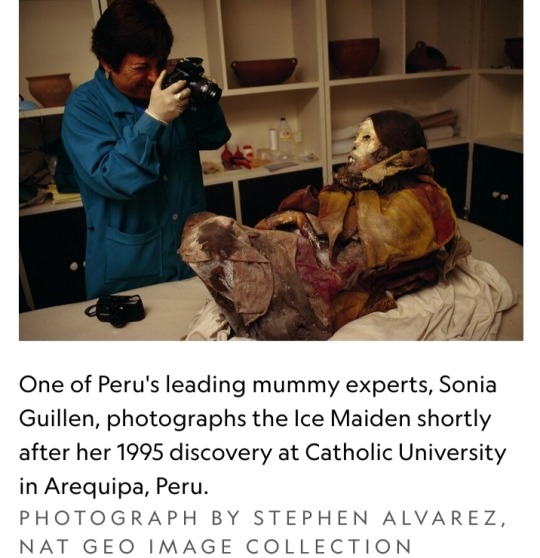
Most of the information we have on capacocha, however, is second hand, notes Dagmara Socha, an archaeologist with the Center for Andean Studies at the University of Warsaw who studies the ritual and commissioned the facial reconstruction of the Ice Maiden of Ampato.
“No European colonist ever saw the ceremony,” she explains.
Despite gaps in the historical record, the high-altitude archaeological finds of more than a dozen Inca children on Ampato and other mountains point provide critical evidence for what happened during these rituals.
The means of sacrifice varied, perhaps due to customs related to specific gods. Some children were buried alive or strangled; others had their hearts removed.
The Ice Maiden’s life ended with a single blunt-force blow to the back of the skull.
In search of the Ice Maiden
Oscar Nilsson knows that skull intimately: He spent months with a replica of it in his Stockholm studio, eventually fashioning a sculpture of the 14-old-girl that, glimpsed from afar, almost seems alive.
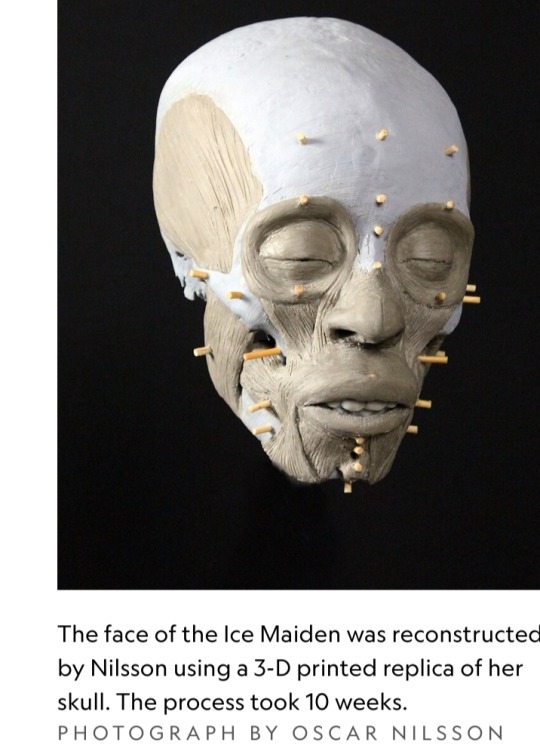
It’s a two-step process, says the Swedish archaeologist and sculptor.
First, Nilsson immerses himself in the world of his subject with an archaeologist’s eye for detail, digesting as much data as possible to understand what she might have looked like.
Even without a mummified face, he can extrapolate the likely depth of the facial tissue that once draped over those bones, using everything from CT scans to DNA analyses to information about diet and disease to make educated guesses about the individual’s face.
Then came the handiwork. Nilsson printed a 3-D replica of the Ice Maiden’s skull, plugging wooden pegs into its surface to guide the depth and placement of each hand-crafted, plasticine clay muscle.
Eerie eyes, masseter muscles, a nose, the delicate rope-like tissues that constitute a human face: each was added in turn.
After making a silicone mold of the bust, he added hundreds of individual hairs and pores in shades of brown and pink.
It took ten weeks.
Following the Inca Gods
The result, wrapped in robes woven by local women from Peru's Centro de Textiles Tradicionales, is the main attraction at “Capacocha: Following the Inca Gods” at the Museo Santuarios Andinos in Arequipa, Peru through November 18.
The reconstruction will be displayed alongside the Ice Maiden’s mummy, accompanied by the stories of 15 other children selected for capacocha atop Ampato and other Andean peaks.
Their ages range from 3 to about 13. The mummies and skeletal remains of several are featured as 3-D models at the exhibition, which also showcases holographs of some of the sacred items buried alongside them.
These natural mummies offer scientists tantalizing clues about their last days.
When Socha and colleagues conducted toxicological and forensic analyses of the remains of a toddler and four six-to-seven-year-old victims featured in the exhibition, they found they were well cared for in the months before their sacrifice.
They were fed a steady diet of coca leaves, ayahuasca vine, and alcohol in the weeks before their deaths — not as much to intoxicate them as to keep them sedated and anxiety-free as the timeline hurtled toward their sacrifice.
“We were really surprised by the toxicology results,” says Socha.
“It wasn’t only a brutal sacrifice. The Inca also wanted the children to be in a good mood. It was important to them that they go happily to the gods.”
High altitude, psychogenic substances, the spectacular view, the knowledge the afterlife was near — all must have made for an astonishing ceremony, says Reinhard.
“The whole phenomenon must have been overpowering.”
During the last phase of his reconstruction, Nilsson spent hours contemplating and attempting to capture the young girl’s presence 500 years after her death.
The result is both unsettlingly realistic and jarringly personal.
“She was an individual,” the forensic reconstructionist says.
“She must have understood her life would end on the mountaintop in a couple of weeks. We can only hope that she believed in the afterworld herself.”
For Reinhard, finally seeing the face of the girl he carried down the mountain on his back decades ago brought the Ice Maiden’s story full circle.
“It brings her back to life,” he says. The reconstruction brings the focus as much to her culture and daily life as to her spectacular death.
But Nilsson never forgot the way the Ice Maiden died, even as he brought her to life through his reconstruction.
More than anything, he says, he wanted to capture a sense of being frozen — a nod not just to her icy, mummified future but to a girl teetering on the edge of eternity, though still very much alive.
“She knew she was supposed to smile, to express pride,” he says. “Proud to be chosen. But still very, very afraid.”
#Ice Maiden of Ampato#Inca Girl#archaeological analysis#forensic reconstruction#human sacrifice#Peru#3-D bust#Juanita#Johan Reinhard#Mount Ampato#National Geographic#National Geographic Explorer#expedition#1990s#20th century#capacocha#Inca ritual#Inca Empire#Dagmara Socha#facial reconstruction#archaeology#archaeologists#Oscar Nilsson#sculptor#Centro de Textiles Tradicionales#Capacocha: Following the Inca Gods#Museo Santuarios Andinos#natural mummies#culture#forensic reconstructionist
2 notes
·
View notes
Text
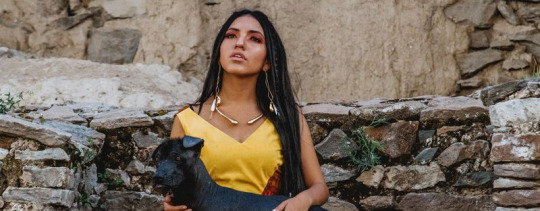
Renata Flores Rivera y su perro
#Andean pride#Ayacuchana#Quechua artists#qpop#mujer andina#trenzas andinas#trenzitas chola#ndn tumblr#american south native#native south american#qawanskankchikchay killayata#brown skinned#andean fashion
11 notes
·
View notes
Note
Hi @prophetic-hijinks !!! I need some tips about colombian fashion. You see I need a new design for Sonia's new dress & Need help choosing the right style of fashion during Encanto. Google & pintrest aren't really helping me. I've seen Elena's fashion & love it!!! May I get some tips?
Elena being a city girl means she can draw a lot of her designs From 1950s Hollywood. Some movies were coming translated to Colombian around that time. And if you look up nightlife Columbia 1950s you can see their fashion was not too out of kilter with the fashion of Americas. I purposely have Elena dressed in Garments that Rita Hayworth might have wore, because I modeled Elena after her. Also there seemed to be a large mercantile and fashion district in Bogota the capital city.
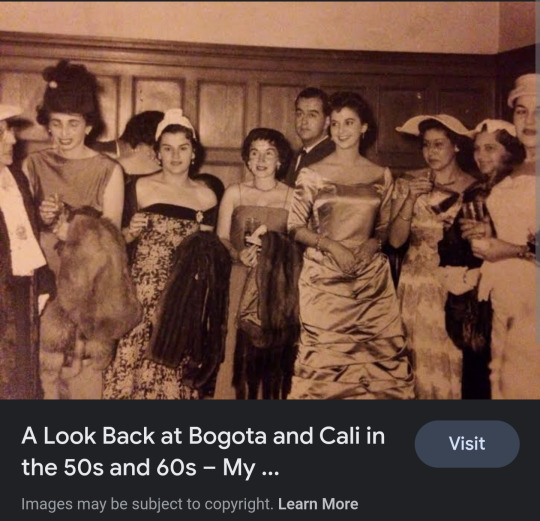

One thing I try to keep in mind with the 1950s fashion when I do borrow it is they're not appropriate in the Encanto. So Elena does adjust her fashion depending where she is. This is due to being a Catholic modest society so no slinky dresses outside of the city, or their bedroom. She will wear her pants in the Encanto, which is fairly risque.
Another details the fabrics. Within the Encanto you're going to have cotton, or wool like fabrics. A bit heavier with stronger folds and embroidery details. Which kind of gives it a structured look and if. This is because they're making fabrics from hand woven techniques. Pepa's dress is like a cotton, while julieta's appears to be maybe wool, but not woven. Looks almost Wool felted, but I am open to correction.
But Elena has the benefit of access to new textile technology of elastics, mix fabrics like polyester's. That gives her a little bit more of a stretch to her fabric, so they could be a bit more curve hugging. Unless you have a very structured look like, say Alma's dressed where you can see the lines as it goes around each part of the body.
For your redesign, it comes down to whether or not you're Encanto is open to the world. And how much money you have. Isabella's dress those are hand embroidered details and handmade flowers that is insanely expensive. And not so easily purchased. This expense is why we may see Pepa's wedding dress dyed to be colorful (or it's too save on models, but that was by no means an uncommon practice)
But Augustin proves that different people from different regions of Colombia have put their mark on the town. Perhaps Sonia has some luck and comes across some very nice silk kind of fabric.
The art of Encanto goes into more detail of where the Encanto draws their inspiration from (I believe the Andean coffee region) but there are details from all over Colombia. They also have a concept where Mirabel went to the city, so you can see the artists interpretation of city fashion of the era.
https://disney-studios-awards.s3.amazonaws.com/encanto/books/flipJSi56TV4ke/index.html
In the end I am not much a historian, but I tried my best to learn. But I have made Elena a bit of a fashion forward, Hollywood cinema nerd.
18 notes
·
View notes
Text
The Nahua also provide a good look at patriarchy and civilization:
They are the most recent example on the list in historical and cultural terms, and not just terms of Mesoamerica, in terms of history in general. The Aztec Empire was the last phase of the great Mesoamerican civilizations, as their own sources note with the history of the great migration and the rise of the Triple Alliance and the great cities. They were one of many dispersions of Uto-Aztecan peoples. Women were not equal in Aztec society at ideological or real world levels, and there was an ideology of misogyny baked into the religion and into the practical manifestations of that civilization.
Why does this matter? Because in a case of something as close to vacuum sealed as possible, Mesoamerican and Andean civilizations still developed all the oppressive trappings of all other civilizations. Great cities, great armies, the oppressive iron fist....and patriarchy. It makes both the inseparable connection between patriarchy and civilization inarguable, and delineates the pitfalls in seeking to recreate the Garden of Eden and the Fall in a secular guise.
Patriarchy has many origins and appeared at multiple times in multiple fashions. Here is my answer to its rise and to why it repeatedly appears in specific contexts across the world.
2 notes
·
View notes
Text
What is the Meaning of this Exercise. A Follow-up to “The Students”.
What is the goal of this communication? I was joking with a correspondent that it was to make myself “uncancellable” and thus free to express because the symbols that I use are not immediately recognisable to the native Anglophone reader; I will be content with a half-a-second advantage before the verdict, which is already more than is granted to those who use the fashionable vocabulary. That is to say… You are free to cancel me, but first understand that you disagree with me.
But speaking more genuinely, my goal is to express the reality I experience through forms that are more recognisable to myself, who always felt more comfortable with the meanings expressed in books than the live-spoken words of my congenerates. Book words were composed by humans too, but these are the practised words, especially before the keyboard age. The word is the drawing of the word sound and in the span of its conjuring there is time enough to contemplate. How would my thinking be different if I had first learned to write in pictograms? Many of them are written in fewer strokes, and so, with more speed, I could imagine and be wrong completely, and each of them encompasses a meaning.
What does this composition read like, in my imagination? A translation from another language. Someone writes for a subscription in the backwaters of X, regurgitating misrepresentations of the writings of a mysterious group of people called the “Europeans,” who may as well not exist, or if so be on the same plane of unreality as Sokrates, known only from the words of others. But what is less real than this but life, which is what happens in the background. It is shameful, again, to say “Something must be done!” The same question without resolution for the interminable centuries. Meanwhile the country, and by this I mean the physical place that you can touch with your own hands and measure, is falling to rust and unswept red brick dust. None of our problems are unique, though the nationalists would lie to you that they are. How they hate to hear that the same thing, more or less, is happening somewhere else! Other places have their names for the Republic of Indians and the Republic of Spaniards, and whenever a writer mentions the phrase “Andean idiosyncrasies” or what makes me spit up in anger, the butchered New Age “cosmovision” to explain serfdom or state corruption it is as meaningless as when someone were to say, for example, communism or capitalism with Chinese characteristics. There are social and economic reasons, not some unique quality of the soul. That is what we tell foreigners when there is something that we want to sell to you.
As an aside, at a certain time, these two regions did experience a similar search for identity, or rather an attempt to create one. For lack of knowledge of the one I will not comment as to the success of either case. Only to say that I prefer the idea of the community as a group of people that interact to form a relationship with one another, rather than the community that is predicated on a collection of traits that serve to unite the group at the exclusion of others. These definitions coexist and each serves its purpose in describing social phenomena, but the reason to document our reality should be to use put this information to use, and make a choice about what we actually would like to see.
It is easier for me to think when I write; this is an exercise to make myself more aware of the impressions that I collect, and I do not expect it to be of use to anyone else, except to receive a clearer image of another human filtered as it is through an affectation of style (unnecessary) and a degree of self-censorship (necessary to survival). As for this style, so long as the rest of the world continues to drag around the corpse of the 19th century and novel pathogens continue to ripen from the same old source I will continue to reflect this in my sorry compositions.
Goodbye, until the next time. And goodbye, until the next time.
3 notes
·
View notes
Text
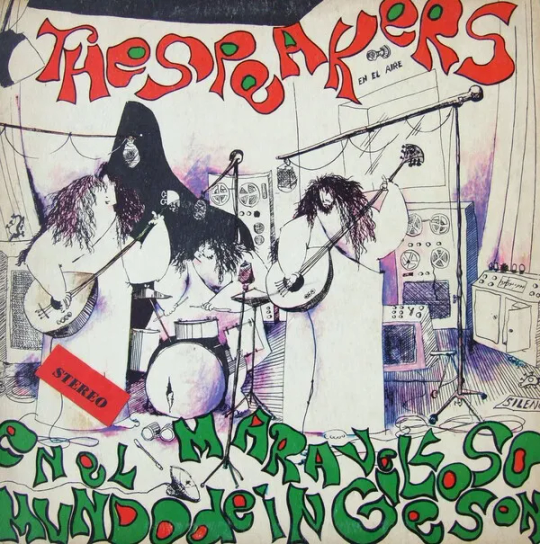
Album Review #50 - En el maravilloso mundo de Ingeson by The Speakers
This album feels like an orphaned child in the vast landscape of music, completely forgotten in its own land. It represents an eclectic mix of beautiful amorphous Psychedelic Pop, sleek Garage Rock and pretty Baroque.
Rock never truly formed a movement in Colombia around that time (the examples of these era are limited to a handful of artists). Radio took longer to get here due to the country's challenging terrain—three Andean mountain ranges no less, and when it finally took off, all genres that preceded Rock, the Swing, Blues, etc, were long gone, leaving Rock to fight with no context as to its existence and therefore ending with a handful of enthusiasts. And this album? This album was one of those incredible exceptions. Even a lot of Rock artists in the 60s were influenced by Presley and others, they wanted the rebellion and were looking for imitation, it was only when these guys said, "hey, lets experiment and look for some wacky sounds!" That this album came to light. Do you think a label ever accepted to produce it? Never, absolutely no fucking way, not in a million years. It was independently produced in a limited run of 1,000 copies with money of the band members themselves who managed to sell around 850 copies door to door. The studio? It was lent by the owner once they added its name to the album title. It was the first of its kind back then and it was available, because a lot of people still preferred to keep recording the old fashioned way so the studio wasn't being used by many. This record came to be without the infrastructure to support its artistic statements and the fact it exists is just wild.
It sounds very influenced by The Piper at the Gates at Dawn but with a closer approach to Baroque Pop. Oda a la Gente Mediocre with it's polyrhythmic jam, the Medieval Ode of Por la Mañana, the quirky Historia de un Loto. Many songs here pull a kaleidoscope of beautiful soundscapes. Socio-political commentary like Si La Guerra es Un Negocio, and the beautiful solo section in Nosotros, Nuestra Arcadia. Everything here is vibrant and wonderfully intricate. It is music made by and for those who wished to explore. It has an air of stream of conciousness and surrealism with an air of playful fantasy and fairy tale that I really love.
This is the type of thing that you do, no one acknowledges for 40 years, and then, half a century later, someone stumbles upon it and someone comes to you and tells you, “Hey, this was pretty cool!” The album isn't even available here, the 2008 reissue? It was made in Spain. Most available copies? You get them from the United States. Most people never cared for it or even knew of its existence. But the truth is that this album is simply and always be incredibly beautiful. It will be, forever and always, one shining rare gem of its own kind.
7/10
#colombia#the speakers#experimental rock#psychedelic pop#60s#garage rock#underground music#album review#music review#south america#latin rock#the piper at the gates of dawn#baroque pop#psychedelic rock#psychedelia#rock en español#obscure#commercial failure
1 note
·
View note